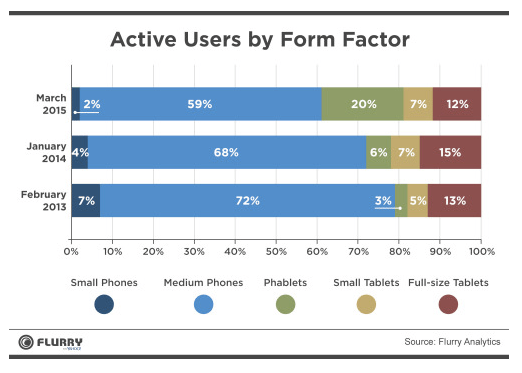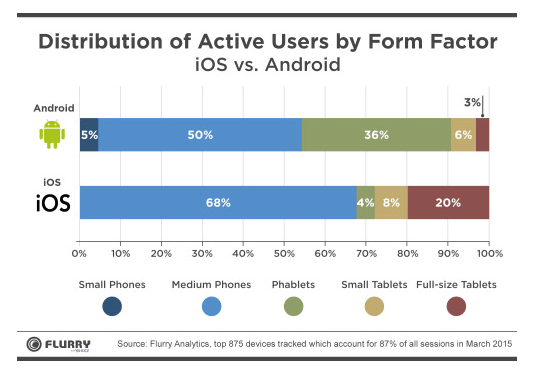The change is evolutionary. And it's based on usage, function - and the ultimate motivator of everything in consumer tech: convenience.
Who talks on the phone anymore? The data say texting, internet surfing, watching videos or tv or live events, taking photos to be posted on social media, have all taken precedence. And to do those things well, or at least with greater clarity and more efficiently, a bigger screen helps.
Despite the industry hype, people do not want to be bothered with too many devices. Aside from being financially insupportable, it is..dah dah DAH dah...inconvenient. The phablet is a Darwinian response to the environmental reality of technological evolution: the survival of the fittest. JL
Natasha Lomas reports in Tech Crunch:
Phablets have more than tripled their share of usage since last year with medium phones squeezed down. Full-sized tablets are also being cannibalized with a shrinking share of active users.
It’s been increasingly evident for years: smartphone users are digging bigger phones as they do more on screens, and spend less time talking on the phone. And there’s no sign of the appetite for super-sizing mobile handsets abating — not according to a new report from Yahoo-owned mobile analytics firm Flurry.
The firm has looked at a top slice of data taken from the 1.6 billion devices it tracks every month — focusing on the top 875 devices it says accounted for 87 percent of sessions in March 2015 — to explore global active device usage by screen size. Flurry found that phablets have more than tripled their share of usage since last year.
In January 2014, Flurry recorded just 6 percent of active users were on phablets versus 68 percent using ‘medium phones’ (devices with a screen size between 3.5 inches and 4.9 inches). But by March this year phablet usage had swelled to a fifth (20 percent), with medium phones squeezed down to 59 percent.
Full-sized tablets are also being cannibalized — or capped — by phablets, with a shrinking overall share of active users:
Apple’s first phablet, the iPhone 6 Plus, went on sale last fall — finally affording iOS users who want to remain on Apple’s platform the option of using an i-Phablet. That pent up demand has evidently contributed to driving phablet usage.
That said, Android remains the dominant force in phablets — which is not surprising, given how many more large-screened Android smartphones there are to choose from versus just the one iPhone. Flurry found that around one-third (36 percent) of Android users are using phablets versus just 4 percent of iOS users. So iOS developers are still mostly going to be focused on building smaller phone experiences — and on iPad apps (full-sized tablet usage accounts for a fifth of iOS usage).
By contrast, Android usage on full size tablets is very weak (just 3 percent) — underlining what we knew already: that Android tablets have flopped, but also that there has been less impetus and demand for full-sized Android slates because Android phones have had larger screens for longer.
Flurry has also charted the growth in Android device makers offering phablets — noting that Android phablets only made up 10 percent of overall Android phones back in 2013. But, two years on, phablets account for close to a third (27 percent) of all Android devices. So really the Android phablet is the Android tablet.






















1 comments:
This is a great site, I recommend it https://flagma.com/ru/products/smartfony-i-mobilnye-telefony/ .
Post a Comment